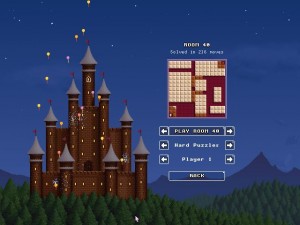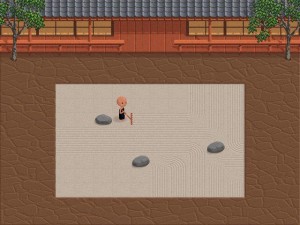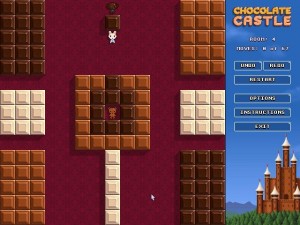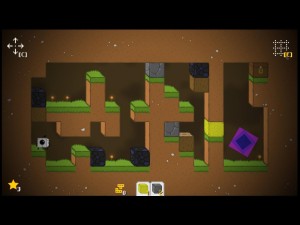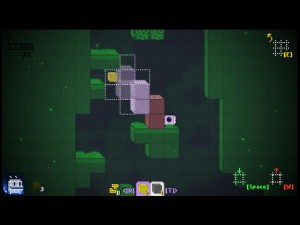Antichamber
Antichamber is distilled essence of Portal — by which I mean, it’s got the same underlying components, but with the flavor replaced with a chemical tang. It’s purged of impurities like plot and humor, abandoning any pretense of setting, leaving just a gun for manipulating the environment in novel ways and a labyrinth of stark white corridors, illogically-connected and rendered in a deliberately non-photorealistic style to enhance the sense of unreality. The strongest way it differs from the formula established by Portal (and followed by Qube and Quantum Conundrum) is that it isn’t a linear series of puzzles. It’s a network of them, with obstacles you can’t overcome the first time you encounter them, Metroidvania-style, and enough loops and branches that you can actually get lost.
It only takes a few hours to beat, leaving aside optional collection for completists. It strikes me that there’s a particular design problem to providing a sense of finality in a thoroughly abstract and unexplained environment; Antichamber manages it largely through a longish final animation that communicates “massive forces unleashed”. Browsing forums afterwards for stuff I missed, I came across an interesting question from someone who hadn’t played the game yet: “Is Antichamber scary?”
I’ll say right off that the answer is “No”. But it’s an interesting question because it’s a reasonable one. This is a game whose basic premise is that the world doesn’t work by the rules you’re used to. That alone can be very nervous-making. The last game I played along similar lines was The 4th Wall, which I found extremely frightening. Not everyone’s in agreement about that, mind you; comment threads about T4W tend to be split between people completely creeped out by its disorienting alienness and people who it completely left cold. (There doesn’t seem to be much of a middle ground. It might be interesting to compare the gaming habits of the people on either side.) But T4W at least tries to make things feel unsafe, pulls tricks like having things that chase you, punishing you for ever standing still, even while you’re still trying to figure out what you’re supposed to be doing. Antichamber never really punishes you, except with puzzle-solver’s frustration. Even when the floor crumbles and vanishes under you, and you fall down a very deep pit, friendly signage at the bottom reminds you that what you’ve really done is find a hidden passage.
For another thing, the “doesn’t work by the rules you’re used to” aspect doesn’t really last the full length of the game. It really only has so many tricks, and once you’re used to them, well, it’s no longer the case that it doesn’t work by the rules you’re used to. There are portals, of course, but we’re definitely used to thinking in terms of those by now. Some portals are obvious and highly visible, but one of the basic ways it disorients you is with inconspicuous one-way portals, or possibly just silent teleport triggers that send you to a place that looks exactly like where you teleported from until you try to go back the way you came in and realize it isn’t there any more. But that’s a trick as old as Wizardry; once you know it’s something that can happen, you just get into the habit of checking your tail once in a while. Then there are innovations in the use of look-triggers: not just where you are, but which direction you’re facing can be important. A more realistic game might use this to control NPC behavior, making enemies dodge when you aim at them and the like, but in the Myst-like solitude of Antichamber, it either controls more of those unnoticeable teleports I just mentioned, or affects the environment in more direct ways. Early on, for example, there’s a door that slams shut whenever you look at it, and which you therefore have to walk through backwards. Then there’s the relatively trivial matter of walls/floors that appear or disappear as you near them. And that’s basically it as far as violations of physical law go. The opening area has some stair-stepped walls that hint at an Escher-like variation in the direction of gravity, but that never happens.
So what does the game spend its time on once you’ve got a handle on its limited repertoire of space-manipulation? Block puzzles, mainly. It’s not quite what it sounds like: the blocks are cubical, maybe fist-sized, and completely immobile, even if suspended in midair, unless affected by your upgradable block-manipulation gun, which, in its simplest form, just lets you pick the blocks up and place them elsewhere. Some doors can only be opened by solving a self-contained block-manipulation puzzle in a panel next to it, which seemed at first like soup-cans design (although I’d hesitate to call anything a soup can in this game; it’s more like the whole complex is one massive soup can), but in at least some cases, the panels are really tutorials in disguise, teaching block-manipulation techniques applicable outside the panels. It reminds me of something pointed out in Portal‘s developer commentary, how they put a checkerboard pattern on the floor wherever the “fling” maneuver was useful, but only up to a certain point in the game, after which you were expected to be able to think of it on your own. I do have a complaint about the block gun, which is that using the more advanced powers — such as sending a group of blocks moving along a vector — requires moving the mouse while holding down the middle button (that is, the scrollwheel), which is especially awkward on my trackball. There’s currently no way to rebind controls in-game, although apparently you can do it by editing .ini files.
So basically this is a confusingly-laid-out 3D puzzle game, mostly about blocks but themed around counterintuitive spatial weirdness. It’s still a pretty good game, with satisfying puzzles based around slowly realizing what your capabilities are, but I feel like the surrealism aspect has been exaggerated, because it’s the most obvious thing about it at first glance.
 Comments(0)
Comments(0)
